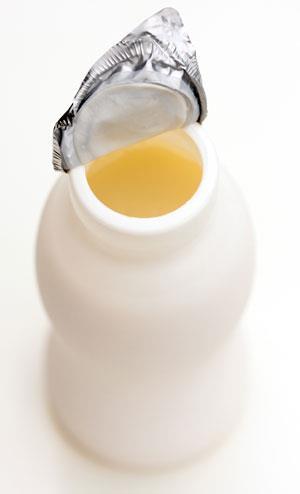Meera Senthilingam
This week the compound many athletes may dread, but has a range of benefits both in and out of the body. Sprinting along with its science is Jessica Gwynne
Jessica Gwynne
If you've ever felt your muscles burn while you're exercising, you've felt the effects of lactic acid. But did you know that this painful little molecule is crucial to providing your body with energy during exercise?
Lactic acid, or 2-hydroxy-propanoic acid, is found in virtually all biological tissues and fluids, and was first isolated from curdled milk in 1780 by the Swedish chemist Carl Wilhelm Scheele, famous for discovering many elements, including oxygen, but not getting the credit. One of its most important roles is in the supply of energy to muscles during strenuous exercise.

Animals store energy in the form of a polysaccharide called glycogen, primarily in cells in muscles and the liver. To release energy, the glycogen is broken down in a series of steps, first into glucose, and then into pyruvic acid, which deprotonates to form the pyruvate ion. During normal aerobic respiration, pyruvate feeds carbon into the Krebs cycle in which adenosine triphosphate, or ATP, is released. This is finally broken down by enzymes in cells to provide energy.
Of course, aerobic respiration requires oxygen, but during strenuous exercise, such as sprinting, oxygen is used up faster than it can be delivered to the muscle cells. Instead, ATP is produced anaerobically, with pyruvate being used as an oxidant instead of oxygen. Pyruvate itself is converted to lactic acid. This is a less efficient way producing energy, but can occur much more quickly. To some extent, this type of energy production actually occurs all the time, but dominates when the supply of oxygen doesn't keep up with the demand.
The accumulation of lactic acid may cause the burn felt in your muscles during exercise, and for a long time, it was also thought that lactic acid was responsible for the muscle ache that you feel the following day. In reality, however, this soreness is caused by muscle damage and tissue inflammation. When you stop exercising, or when you slow down, any remaining lactic acid doesn't stick around for long in your muscles - it can either be converted back into pyruvate, and used in aerobic energy production, or converted back into glycogen and stored in the body.

While anaerobic energy production is crucial for sprinters, endurance athletes, such as marathon runners, rowers and cyclists, are able to remain below their "lactate threshold", which is the exercise intensity at which lactate starts to accumulate, and produce most of their energy aerobically.
The build-up of lactic acid in your muscles isn't the only way it gets into your life, however. Fermentation is another form of anaerobic respiration, and it's through this route that lactic acid produces the characteristic acidic flavour of yogurt. It is produced through the natural fermentation of the lactose sugar in milk by bacteria such as lactobacillus bulgaris and streptococcus thermophilus. Sauerkraut is produced in a similar way, by the fermentation of cabbage, and sourdough breads are made from a starter dough that contains lactic-acid-producing bacteria.

Lactic acid, often in the form of either sodium or potassium lactate, is also used commercially as an additive in a wide variety of foods. It is used to regulate the pH of drinks such as fruit juice and beer, and due to its antimicrobial properties but mild taste, it is commonly used as a preservative to extend the shelf life of things like meat, fish and salads.
Lactic acid can also be polymerised to form polylactic acid, or PLA. This is a biodegradable material, which can be used to produce compostable plastics, but it also has important applications in biomedical materials science. It can be used, either on its own, or as a copolymer with polyglycolic acid, to form resorbable sutures and screws for immobilising fractured bone fragments. These are designed to maintain their strength long enough to allow healing to occur and then degrade over time so there's no need for a second operation to remove them. And since PLA just degrades to form lactic acid, which occurs naturally in the body anyway, the degradation products are non-toxic.
Lactic acid is chiral, which leads to there being several different types of PLA, depending on which optical isomer is polymerised, or whether a mixture of both isomers is used. This means that the properties of PLA can be tailored to fit different requirements, as you can tweak its melting point, glass transition temperature, crystallinity, strength and degradation time.
So, from a quick burst energy under difficult conditions to tasty yogurt and biodegradable bone screws, there's a lot more to lactic acid than just a pain in the...muscles!
Meera Senthilingam
Indeed, there's also the flavour of our foods. That was Cambridge University's Jessica Gwynne with the chemistry of a compound providing energy in our time of need: lactic acid. Next week, a truly toxic compound
Josh Howgego
Hear the word 'hemlock' and we instantly think of something malevolent. Hemlock is actually a plant, which can grow up to 10 feet tall on the marshes and wetlands across Europe. It has long white roots which look quite a lot like wild parsnips. But don't be fooled - it would be a serious mistake to cook these bad boys up for a Sunday roast.
Hemlock is also known as poison hemlock and, true to its name, the plant is extremely poisonous. That's because it contains eight or so toxic compounds known as alkaloids. The most deadly of these is coniine
Meera Senthilingam
And to find out just how deadly coniine really is, join Josh Howgego in next week's Chemistry in its element. Until then, thank you for listening, I'm Meera Senthilingam.













No comments yet